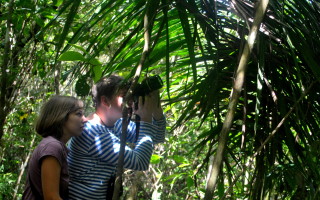As early as 1991, the Department of Environment and Natural Resources through Administrative Order No. 36 had included the Philippine tarsier among the national protected wildlife species and proposed its listing under Appendix 1 of the Convention on International Trade in Endangered Species (CITES).
Moreover, the IUCN/SSC Primate Specialist Group had given the specie Conservation Priority Rating 4, which means that the specie is highly vulnerable and threatened by habitat destruction and/or hunting. Thus, the Philippine Tarsier Foundation’s recommendation to establish the Philippine Tarsier Conservation Program was met with favorable and relatively swift response by the proper authorities.
The ensuring Memorandum of Agreement of April 21, 1997 between the DENR and the Foundation sets forth the objectives of the Program as follows; “To establish a forest reserve on the island of Bohol which shall serve as the sanctuary of the Philippine tarsier ; to protect and manage the tarsier sanctuary through the active participation of the local communities; to establish and maintain a wildlife research laboratory for the study of the ecology and biology of the Philippine Tarsier; to establish and maintain visitor facilities for ecotourism and disseminate information material about the Philippine tarsier with emphasis on the species protection and conservation.”
In furtherance of these imperatives, the Foundation has put together a four-point program of action delineating the tasks it is prepared to assume in such wise, to wit:
• Tarsier Research, which will study the tarsier’s biology and behavior; record its population and distribution; identify habitat and food source; and develop instructional or educational materials.
• Tarsier Habitat Management, wherein the perimeter of the sanctuary will be defined and its topography surveyed and mapped; vegetation and wildlife within assessed; all flora and fauna inventoried and indexed; appropriate signage installed in strategic places; and adequate measures taken to ensure the integrity and security of the reservation.
• Community Management, to entail establishing, maintaining and continuously updating community profiles in the area; regularly conducting dialogues and like activities to enlighten local residents on the purposes of the sanctuary and encourage their cooperation and participation toward achieving these; integrating tarsier conservation into their day- to- day activities; and envisioning and implementing awareness and income-generating projects.
• Visitor Management, leading to the development of an overall site plan; the design and layout of essential facilities; the identification of significant areas and potential attractions; the construction of a visitor complex; the laying out of nature pathways and trails; the design of ecotours and the training of guides for them; and the production of tourism-related materials.
The groundwork for the foregoing activities is now being laid by the Foundation through a series of environmental, topographic, photographic and social surveys of the Tarsier Sanctuary and its vicinity; the commission of a comprehensive site plan, including the architectural design of the planned visitor complex and other support facilities and amenities; the collation and cataloguing of all available research materials on the Philippine Tarsier from various institutions and agencies in the country and abroad; and the production of information and promotional materials.
In Bohol, the foundation has also encouraged the formation of the Friends of Tarsier, an association composed of local professionals, businessmen, government executives and workers, and students committed to the tarsier conservation effort in particular and environmental protection and preservation in general.
Meanwhile, appeals for both financial and technical assistance have gone out to various organizations, corporations and individuals, public and private, Filipino as well as foreign, which have shown themselves to be similarly minded and are past and present contributors to such causes.
Happily, the first to respond to these solicitations has been the Department of Tourism, which has released to the Foundation a generous grant earmarked for projects and activities in the ecotourism field.
These apart, two important events that occurred around the middle of the year have set the Philippine Tarsier Conservation Program to a very good start and most significantly boosted its chances of success.
On June 23, 1997, President Fidel V. Ramos issued Proclamation No. 1030, “Declaring the Philippine tarsier (Tarsius Syrichta) as a specially protected faunal species of the Philippines”.
And shortly after, on July 3, 1997, during the visit to Manila of Charles, the Prince of Wales, an ardent conservationist, His Royal Highness consented to be symbolically presented with a pair of the species in the presence of the President of the Philippines and Madame Amelita Ramos in Malacañang Palace. Fittingly, however, the Prince immediately reconveyed the tarsiers back to the foundation for safekeeping.
